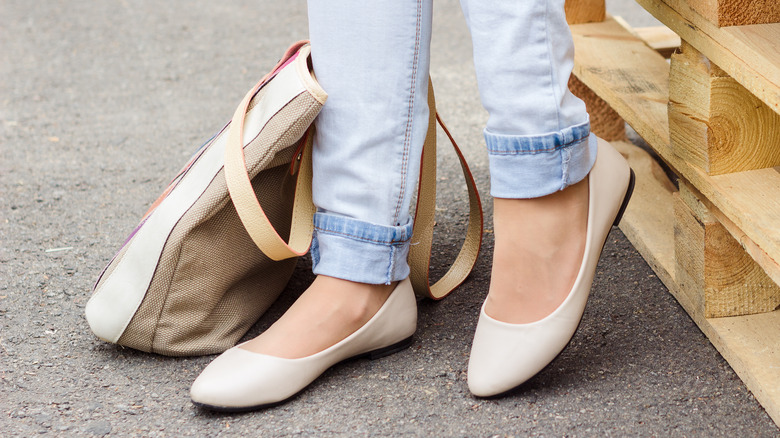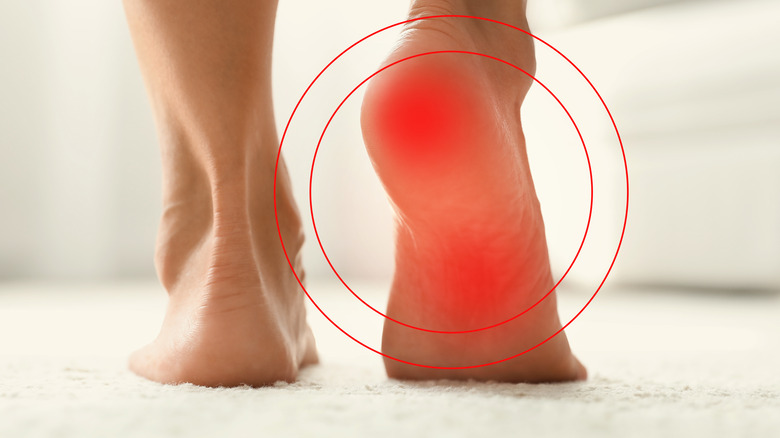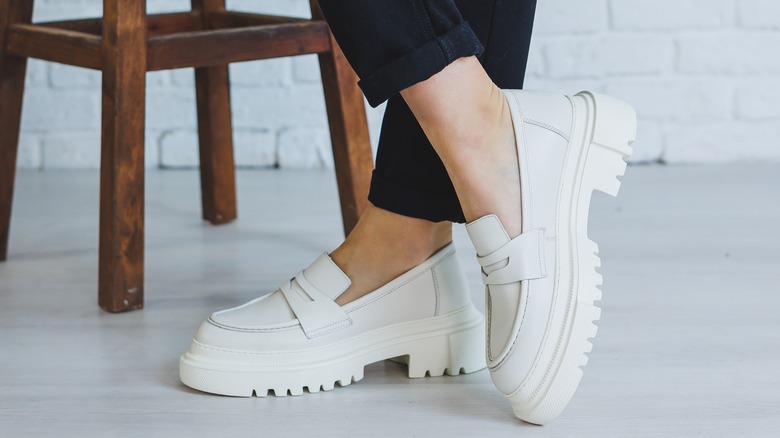The Unfortunate Truth About Beloved Ballet Flats
Ballet flats have been a cult-favorite shoe for years. These round-toed, flat-heeled shoes for women are meant to resemble those that ballerinas wear. In the beginning, designers in the 1940s began to take the shoe style of ballerinas to the streets. This style ended up on the foot of fashion icon and actor Bridgette Bardot in the 1950s, which ultimately led to the meteoric rise of the shoe on the everyday person (via Aerosoles).
As the years went on, the flats became even more popular, particularly in the '90s and early 2000s. Celebrities throughout the years have even been obsessed with ballet flats. From Princess Diana to Emma Stone, they've always been a hot commodity. In 2022, despite new aesthetics appearing constantly, ballet flats are as popular as ever. Everyone seems to have a few pairs in their wardrobe rotation this year, with the traditional Chanel Ballerinas especially being on fire.
Ballerinas wear flat-footed, tight, and thin ballet slippers for maximum flexibility and safety (via Dance Facts). Though this is essential for ballerinas and has been modified for streetwear on traditional ballet flats, there are some unfortunate risks that come with wearing ballet flats in daily life.
Why ballet flats are risky
Unfortunately, ballet flats have been linked back to poor foot health. Dr. Brad Schaeffer, a board-certified foot surgeon at Sole Podiatry N.Y.C., told InStyle that ballet flats are generally bad for the feet due to poor support.
Some side effects of over-wearing ballet flats are long-term issues like inflamed muscles, tendons, and bones. The most common inflammatory condition caused by ballet flats is plantar fasciitis, which is inflammation of the thick ligament that connects the heel bone to the toes (via Healthline). This causes severe pain. Therefore, support and comfort are the keys to good foot health when it comes to the shoes we purchase and wear. Commonly, ballet flats are known for not only causing overall foot pain but also causing sores and marks. What's more, Dr. Schaeffer explains that he tells his patients they should always go for shoes with a wide toe box, a cushioned heel, and great arch support — all features that ballet flats do not have. Even the most expensive, designer ballet flats are often flimsy and unsupportive compared to other shoe types.
Ballet flats also have some other tragic risks. One risk is putting your foot in a vulnerable position, susceptible to sprains and tears due to poor support. Another risk is that their thin sole can be punctured easily by sharp objects that can hurt your feet (via Advanced Podiatry). Overall, tragically, the risks are often not worth the reward when it comes to wearing ballet flats. Still, there are good alternatives to them that will still keep you fashionable.
Alternatives to ballet flats
With balletcore and cottagecore aesthetics being hot trends at the moment, it is probably devastating for most to hear that ballet flats are bad for foot health. Luckily, there are some swaps to make for healthier feet while still looking trendy. If you still prefer to sometimes wear ballet flats, that is okay! Ballet flats can be worn sparingly and show no side effects. When you do wear ballet flats, ensure that you are not wearing them for long periods of time or in strenuous circumstances. Also, a great pair of shoe inserts, like Dr. Scholl's Hidden Arch Support inserts, can prevent back pain and absorb shock to take away some of the risks of ballet flats (via Woman's Day).
If you choose to give up flats as a whole, even better! There are some great alternatives. Mary-Janes are a great alternative to ballet flats as they provide support on the top of the foot, whereas ballet flats do not (via Who What Wear). Luckily, they give off the same aesthetic to create an iconic outfit! Another alternative to ballet flats is loafers as they provide far more shock absorption, are less flimsy, and have more overall support. This makes for a great excuse to buy the trendy Prada leather loafers! Whereas ballet flats will never truly go away, we are always looking towards a healthier future with less pain and more fashion-forward alternatives.


